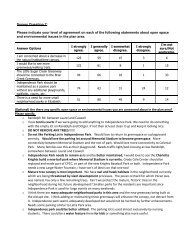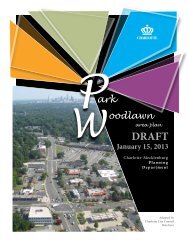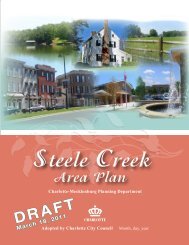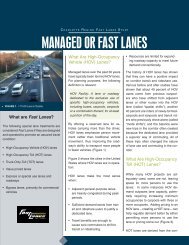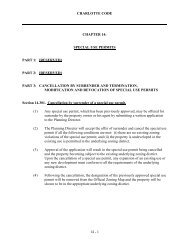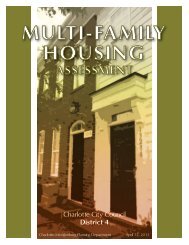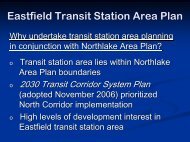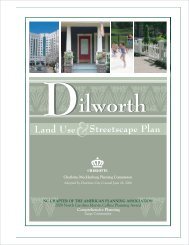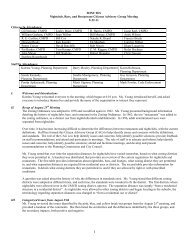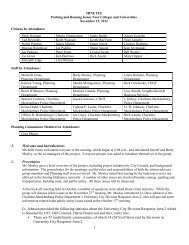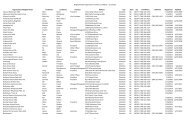transit oriented development districts - Charlotte-Mecklenburg County
transit oriented development districts - Charlotte-Mecklenburg County
transit oriented development districts - Charlotte-Mecklenburg County
You also want an ePaper? Increase the reach of your titles
YUMPU automatically turns print PDFs into web optimized ePapers that Google loves.
CHARLOTTE CODEPART 12: TRANSIT ORIENTED DEVELOPMENT DISTRICTSPART 12: TRANSIT ORIENTED DEVELOPMENT DISTRICTSSection 9.1201 Purpose.The purpose of the Transit Oriented Development (TOD) zoning <strong>districts</strong> is to create a compact,and high intensity mix of residential, office, retail, institutional, and civic uses to promote thecreation and retention of uses in areas with high potential for enhanced <strong>transit</strong> and pedestrianactivity. Pedestrian circulation and <strong>transit</strong> access are especially important and have an increasedemphasis in the TOD zoning <strong>districts</strong>. The <strong>development</strong> standards are designed to requirecompact urban growth, opportunities for increased choice of transportation modes, and a safeand pleasant pedestrian environment by ensuring an attractive streetscape, a functional mix ofcomplementary uses, and the provision of facilities that support <strong>transit</strong> use, bicycling, andwalking.These zoning <strong>districts</strong> are meant to create high density <strong>transit</strong> supportive <strong>development</strong> around<strong>transit</strong> stations, typically the area within one-half (1/2) mile walking distance from the <strong>transit</strong>station, which represents a 10-minute walk.Section 9.1202 Establishment of Transit Oriented Development Districts.There are six (6) Transit Oriented Development zoning <strong>districts</strong>:(1) Residentially Oriented (TOD-R)This <strong>transit</strong> <strong>oriented</strong> residential district is established to support high-densityresidential communities that also accommodate a limited amount of retail,institutional, civic, restaurant, service, and small employment uses within apedestrian friendly area.Residential <strong>development</strong>s and residential components of multi-use <strong>development</strong>sshall have a minimum density of twenty (20) dwelling units per acre within ¼mile walking distance from a <strong>transit</strong> station or a minimum density of fifteen (15)dwelling units per acre between ¼ mile and ½ mile walking distance from a<strong>transit</strong> station. The density shall be based on the residential portion of the site.The approved station area plan classifies parcels according to whether they arewithin the ¼ mile walking distance or between the ¼ mile to ½ mile walkingdistance.Retail, institutional, civic, and office uses are permitted. Only up to 20% of thetotal <strong>development</strong> gross square footage that is composed of these uses may becredited toward meeting the minimum residential densities at a ratio of one (1)dwelling unit to 2,000 square feet of <strong>development</strong>.9-180
CHARLOTTE CODEPART 12: TRANSIT ORIENTED DEVELOPMENT DISTRICTS(2) Employment Oriented (TOD-E)This <strong>transit</strong> <strong>oriented</strong> employment district is established to accommodate highintensity office uses, office support services, or residential uses in a pedestrian<strong>oriented</strong> setting. High intensity office uses and office support services shall havea minimum FAR of .75 within ¼ mile walking distance from a <strong>transit</strong> station, or aminimum FAR of .5 between ¼ mile to ½ mile walking distance from a <strong>transit</strong>station. The approved station area plan classifies parcels according to whetherthey are within the ¼ mile walking distance or between the ¼ mile to ½ milewalking distance. Uses that employ relatively few workers, such as warehousingand distribution, are excluded from this district.Office uses shall comprise a minimum of 60% of the new <strong>development</strong> projectgross square footage.Retail, institutional, and/or civic uses are permitted. Only up to 20% of the total<strong>development</strong> gross square footage that is composed of these uses may be creditedtoward meeting the minimum FAR standards.Only up to 20% of the total <strong>development</strong> gross square footage may be composedof residential uses that meet one of the following standards:(a)(b)The density shall be based on the residential portion of the site. Theresidential component shall have a minimum density of twenty (20)dwelling units per acre within ¼ mile walking distance from a <strong>transit</strong>station. Between ¼ mile to ½ mile walking distance from a <strong>transit</strong> stationa minimum density of fifteen (15) dwelling units per acre, shall berequired, ORThe residential component shall meet the minimum FAR standards. Theminimum floor area shall not be less than .75 square feet of floor area to 1square foot of the <strong>development</strong> site (.75 FAR) within ¼ mile walkingdistance from a <strong>transit</strong> station or not less than .50 square feet of floor areato 1 square foot of the <strong>development</strong> site (.50 FAR) between ¼ mile to ½mile walking distance from a <strong>transit</strong> station.(3) Mixed-Use Oriented (Including Multi-use Developments) (TOD-M)This <strong>transit</strong> <strong>oriented</strong> mixed-use district is established to support a blend of highdensity residential, high intensity employment/office, civic entertainment, andinstitutional uses, as well as a limited amount of retail uses in a pedestrianfriendly area.9-181
CHARLOTTE CODEPART 12: TRANSIT ORIENTED DEVELOPMENT DISTRICTSHigh intensity office uses, office support services, civic, entertainment, andinstitutional uses shall have a minimum FAR of .75 within ¼ mile walkingdistance from a <strong>transit</strong> station, or a minimum FAR of .5 between ¼ mile to ½ milewalking distance from a <strong>transit</strong> station. The approved station area plan classifiesparcels according to whether they are within the ¼ mile walking distance orbetween the ¼ mile to ½ mile walking distance.Retail uses are permitted. Only up to 20% of the total <strong>development</strong> gross squarefootage that is composed of retail uses may be credited toward meeting theminimum FAR standards.Residential uses (as a single use or as a <strong>development</strong> component) are permittedand shall meet one of the following standards:(a)(b)The density shall be based on the residential portion of the site. Theresidential component shall have a minimum density of twenty (20)dwelling units per acre within ¼ mile walking distance from a <strong>transit</strong>station. Between ¼ mile to ½ mile walking distance from a <strong>transit</strong> stationa minimum density of fifteen (15) dwelling units per acre, shall berequired, ORThe residential component shall meet the minimum FAR standards. Theminimum floor area ratio shall not be less than .75 square feet of floor areato 1 square foot of the <strong>development</strong> site (.75 FAR) within ¼ mile walkingdistance from a <strong>transit</strong> station or not less than . 50 square feet of floor areato 1 square foot of the <strong>development</strong> site (.50 FAR) between ¼ mile to ½mile walking distance from a <strong>transit</strong> station.(4) TOD-Optional Districts (TOD-RO, TOD-EO, TOD-MO)The TOD – Optional zoning district may be applied to any of the above three (3)zoning <strong>districts</strong>:TOD-Residentially Oriented – Optional (TOD-RO)TOD-Employment Oriented – Optional (TOD-EO)TOD-Mixed-Use Oriented – Optional (TOD-MO)For more information on TOD-Optional <strong>districts</strong>, see Section 9.1212.9-182
CHARLOTTE CODEPART 12: TRANSIT ORIENTED DEVELOPMENT DISTRICTSSection 9.1203. Rezoning to a TOD Zoning District.As per Section 6.103(1), any amendment for the reclassification of property to a TOD zoningdistrict may be initiated by the City Council, the Planning Commission on its own motion, byany owner with a legal interest in the property, by anyone authorized in writing to act on theowner’s behalf, or by any non-owner in accordance with the procedures set forth in Chapter 6.However, the property must be located within 1/2 mile of a rapid <strong>transit</strong> station that is includedin a project for which the Federal Transit Administration (FTA), has issued a Record of Decisionor be located adjacent to TOD zoned property.(Petition No. 2004-93 §9.1203 10/18/04)Section 9.1204. Applicability and ExceptionsThe Transit Oriented Development District regulations applies to all property where TOD-R,TOD-E, TOD-M, TOD-RO, TOD-EO, OR TOD-MO is indicated on the official <strong>Charlotte</strong>Zoning Map.New <strong>development</strong> within all TOD zoning <strong>districts</strong> shall be subject to the <strong>development</strong> and urbandesign standards of Chapter 9, Part 12, with the following exceptions.(1) Change of Use, Non-Residential to Non-Residential with No Expansion(a)If the change of use in an existing building does not require more than five(5) additional parking spaces based on the minimum/maximum number ofparking spaces required in Section 9.1208(6)(a), then the requirement toprovide the additional parking spaces is waived. Parking in excess of themaximum may remain.9-183
CHARLOTTE CODEPART 12: TRANSIT ORIENTED DEVELOPMENT DISTRICTS(c)If outdoor seating is located within an existing right-of-way or publicsidewalk, an encroachment agreement shall be approved by CDOT.(5) Major facade improvements to existing buildings including buildings with nonconformingusesNew exterior improvements (beyond paint and general maintenance such as roofor window repair or replacement) whose value exceeds 25% of the current listedtax value of the entire property shall be subject to the following.(a)(b)(c)(d)(e)(f)The setback, yard and height requirements of Section 9.1208(1), (2) and(3) shall be met.The urban design standards of Section 9.1209(1) through (4) shall apply tothe new façade improvements.The streetscape requirements of Section 9.1209(8) shall be required ifsidewalks and a perimeter planting strip with trees are non-existent alongstreet frontages.No exterior improvements shall make the building nonconforming, ormore non-conforming in any manner.Any existing, non-conforming parking shall be eliminated from therequired setback. Such elimination shall not require any additionalparking even if the site is rendered non-conforming.The connectivity and circulation requirements of Section 9.1208(11) shallapply.(6) Additional parking for existing <strong>development</strong>(a)(b)(c)(d)The additional parking spaces shall not exceed the maximum number ofspaces permitted under Section 9.1208(6)(a)The additional parking area shall meet the parking standards of Section9.1208(6)(b) through (1)The additional parking area shall meet the outdoor lighting standards ofSection 9.1208(10)If there is any non-conforming parking located in the required setback, itshall be eliminated and replaced with landscaping, patios, and/or relatedamenities. Any such elimination shall not require additional parking evenif the site is rendered non-conforming with regard to parking.9-185
CHARLOTTE CODEPART 12: TRANSIT ORIENTED DEVELOPMENT DISTRICTS(e) If an existing buffer or screening area is removed for more than five (5)additional parking spaces, then a perimeter planting strip, landscaping andsidewalk shall be provided, as per Section 9.1209(8), if they are nonexistent.Section 9.1205. Uses Permitted by RightThe following uses are permitted by right in all Transit Oriented Development zoning <strong>districts</strong>:(1) Automobile and motorcycle sales, including offices and repair facilities, limited to amaximum of 2,500 square feet, with no outdoor sales, display, or storage.(Petition No. 2004-128 §9.1205(1) 2/21/05)(2) Bed and breakfasts (B&B’s).(3) Buildings for dramatic, musical, or cultural activities, stadiums, and coliseums.(4) Buildings for social, fraternal, social service, union and civic organizations, andcomparable organizations.(5) Transit stations (bus or rail) and parking facilities, including Park-and-Ride andKiss-and-Ride facilities.(6) Colleges, universities, commercial schools, schools providing adult training inany of the arts, sciences, trades and professions, and dormitories for the studentsof colleges, commercial schools, schools providing adult training and for the staffof hospitals.(7) Convention centers and halls, conference centers, exhibition halls, merchandisemarts, and other similar uses.(8) Dwellings, detached, duplex, triplex, quadruples, attached, multi-family andplanned multi-family <strong>development</strong>s.(9) Group Homes, up to 10 residents.(10) Health institutions, including hospitals, clinics, and similar uses.(11) Hotels and motels(12) Institutional uses such as religious institutions, churches, synagogues, parishhouses, Sunday school buildings, convents, monasteries, community recreationcenters, country and swim clubs, athletic and sports facilities, libraries, museums,theaters, art galleries, police and fire stations, and public and private elementary,junior and senior high schools.9-186
CHARLOTTE CODEPART 12: TRANSIT ORIENTED DEVELOPMENT DISTRICTS(13) Mixed-use <strong>development</strong>s or multi-use <strong>development</strong>s with a maximum of 30,000square feet of gross floor area per floor, per single tenant.(14) Public and private recreational parks and playgrounds (non-commercial).(15) Open air, fresh food market on private or public property, not including the streetsand sidewalks, for the selling of fresh food, (not consumed on the premises), andplants, but shall be subject to all applicable State laws and regulations. Such anopen air, fresh food market need not comply with the <strong>development</strong> standards ofSection 9.1208.(16) Outdoor seasonal sales subject to the requirements of Section 12.519.(17) Parking decks(18) Parking lots (temporary surface lots), over one (1) acre, subject to the following:(a)(b)(c)(d)(e)(f)Any operator of a temporary parking lot shall apply for a permit fromEngineering and Property Management. The Engineering and PropertyManagement staff shall not issue the permit until the Planning Director, orhis or her designee has granted approval. The permit shall authorize atemporary parking lot for a period of five (5) years from the date thepermit is issued.(Petition No. 2005-78 §9.1205(18)(a),06/20/05)Temporary, surface parking lots shall not be permitted when the lotadjoins a residentially used parcel of land, not zoned TOD-R, TOD-E,TOD-M, TOD-RO, TOD-EO, or TOD-MO, unless the parking lot will belocated on a major thoroughfare.The use shall not require the construction of a permanent building.Any signage, which identifies the use, shall be in accordance with Section9.1209(7).Parking and maneuvering shall observe the minimum setbacks determinedin each approved <strong>transit</strong> station area plan for particular streets, and belocated outside the site distance triangle. When a station area plan doesnot specify a setback the minimum setback shall be 16 feet.The operator is responsible for the removal of any vestiges upon cessationof the temporary parking lot, including signage.9-187
CHARLOTTE CODEPART 12: TRANSIT ORIENTED DEVELOPMENT DISTRICTS(19) Professional business and general offices such as banks, offices, clinics, medical,dental and doctor’s offices, government and public utility office buildings, postoffices, opticians’ offices and similar uses. No more than four (4) drive-throughservice lanes shall be permitted per individual use.(20) Restaurants; including open air or sidewalk cafes. No drive-through servicewindows permitted.(21) Retail sales and service establishments, multi-tenant shopping centers, andpersonal service establishments with less than 30,000 square feet of gross floorarea per floor, per single tenant. No drive through windows or outdoor storage ispermitted.(22) Services such as beauty shops, barbershops, and dry-cleaning establishments. Nodrive-through service windows permitted.(23) Temporary buildings and storage of materials in conjunction with construction ofa building is permitted on, 1) a lot where construction is taking place, 2) anadjacent lot, or 3) an approved lot under common ownership or lease agreement,subject to administrative approval by the City of <strong>Charlotte</strong>, Department ofTransportation (CDOT) and Engineering and Property Management staff todetermine compliance with the following criteria:(a)(b)(c)(d)(e)(f)(g)(h)The storage site is located a distance of at least 200 feet from anyresidential land use or property with a residential zoning classification,Location of approved temporary access to the alternative storage site,Installation of temporary opaque screening to mitigate impacts tosurrounding less intense land uses,Fencing and required signage,Leasing of necessary right-of-way or easements to facilitate safemovement of materials between the two sites during construction,A traffic control and associated operational plan use of the use site duringthe course of construction,Timetable for use of the site and the preparation of an approved siterestoration plan to be implemented prior to the issuance of a certificate ofoccupancy for the principal usePosting of any additional surety guarantee the repair of any publicimprovements that may be impacted during the construction process,9-188
CHARLOTTE CODEPART 12: TRANSIT ORIENTED DEVELOPMENT DISTRICTS(i)Such temporary uses shall be terminated upon the completion ofconstruction.(24) Utility and related facilities such as distribution lines and railroad right-of-way.Section 9.1206. Uses Permitted Under Prescribed Conditions.The following uses are permitted subject to the specific conditions governing each use as set outbelow:(1) Beneficial fill sites, subject to the regulations of Section 12.523.(2) Boarding houses, subject to regulations of Section 12.520.(3) Bus stop shelters, subject to the regulations of Section 12.513.(4) Commercial Rooming Houses, subject to the regulations of Section12.531.(5) Child care centers, nursing homes, rest homes and homes for the aged, inaccordance with the standards of <strong>Mecklenburg</strong> <strong>County</strong> and the State of NorthCarolina for the licensing and operation of such facilities.(5.01) Emergency Shelter, subject to the regulations of 12.537.(6) Entertainment establishments such as lounges, nightclubs, bars, taverns, andcabarets provided they are located at least 200 feet from any residential uselocated in a residential district, or from a residential district.(7) Electric and gas substations, subject to the requirements of Section 12.504.(8) Privately owned parking lots (off-street, principal use) under one (1) acre. Thecombined ownership, interest, or options on adjacent or contiguous property(including parcels across public or railroad right-of way) shall be included indetermining the total acreage of any off-street parking lot. Interest in adjoiningproperty is defined as the same person, immediate family, entity, corporation, orany type of ownership pattern or option where at least one person in common hasa financial interest or option on adjoining parcels of land.9-189
CHARLOTTE CODEPART 12: TRANSIT ORIENTED DEVELOPMENT DISTRICTS(9) Retail sales and service establishment and personal service establishments withmore than 30,000 square feet of gross floor area per floor, per single tenant shallmeet the following:(a)(b)Transparent, clear glass windows and doors shall be visible from and tothe street at least 75% of the first floor street façade of the building, andthere shall be at least one entrance per street frontage; orThe building is designed to accommodate other single tenant uses alongthe linear street frontages to create pedestrian interest and activity.(9.5) Short-term care facilities, (TOD-E and TOD-M only) subject to the regulations ofSection 12.522.(Petition No. 2004-96, § 9.1206(9.5),10/18/04)(10) Single room occupancy (SRO) residences, subject to the regulations ofSection 12.527.Section 9.1207. Accessory Uses.The following are permitted as accessory uses and structures in the TOD zoning <strong>districts</strong>:(1) Accessory residential uses and structures, clearly incidental and related to thepermitted principal use or structure.(2) Information pillars, subject to the regulations of Section 12.416.(Petition No. 2004-112 §9.1207(2) 11/15/04)(3) Vending machines located within an enclosed building for the convenience of theoccupants of the building.(4) Signs, bulletin boards, kiosks and similar structures that provide historicalinformation, information for non-commercial activities or space for free use bythe general public.(5) Land clearing and inert landfills (LCID): on-site, subject to the regulations ofSection 12.405.(6) Wireless communications facilities are only permitted atop a building or structure(other than a single family structure or other residential structure of less than twostories in height). Such facility shall not exceed 20 feet in height measured fromthe top of the highest point of the existing structure. Any such facility and anyassociated antennae located within 400 feet of a residential district shall beindiscernible from the rest of the building or structure.9-190
CHARLOTTE CODEPART 12: TRANSIT ORIENTED DEVELOPMENT DISTRICTS(7) Drive-through service lanes are only permitted when associated with professionalbusiness and general offices, and only when located between ¼ to ½ mile walkingdistance from a <strong>transit</strong> station, as designated on the approved station area plan.Drive-through windows shall only be located on the same site as the principal use,shall be located to the rear or side of the principal use, to minimize visibilityalong public right-of-way. No more than four (4) drive through service lanesshall be permitted per individual use. Freestanding drive-through lanes areprohibited.Section 9.1208. Development Standards.The following requirements apply to all buildings or uses in TOD unless specified otherwise inSection 9.1204:(1) Minimum setback(a)(b)(c)(d)(e)The minimum building setbacks along particular streets shall be determinedby the approved <strong>transit</strong> station area plan for each station. Because stationarea characteristics vary, setbacks within and between stations may vary.When a station area plan does not specify a setback the minimum setbackfor all uses shall be sixteen (16) feet.The minimum setback shall be measured from the back of all existing orfuture curbs whichever is greater. If the existing right-of-way is greaterthan the minimum setback from the back of existing or future curbs, theright-of –way line shall become the minimum setback. If the existing curbline varies, the setback shall be measured from the widest sections. Curblines are to be determined jointly by the <strong>Charlotte</strong> Department ofTransportation (CDOT) Director, or his designee, and the PlanningDirector or his designee.If the new construction incorporates an existing structure located within theminimum setback, the CDOT Director, or his designee, and the PlanningDirector or his designee may allow the setback for the addition to bereduced to the established setback.For the purposes of this section, the minimum setback applies to allfrontages, not just to the street frontage toward which the structure is<strong>oriented</strong>.All above ground, at ground, and below ground utility structuresassociated with underground electric, natural gas, telecommunications orcable television distribution lines, pipes, or conduits shall be locatedbehind the minimum setback. This includes air vents, vaults, andbackflow preventers.9-191
CHARLOTTE CODEPART 12: TRANSIT ORIENTED DEVELOPMENT DISTRICTS(f)(g)(h)(i)(j)(k)(l)No new doors shall be permitted to swing into the minimum setback,except for emergency exit doors.Walls and fences are not permitted in the minimum setback, except foroutdoor seating areas. Outdoor seating areas may be surrounded withwalls or fences, subject to an approved encroachment agreement withCDOT if the wall or fence will be located in the right-of-way or sidewalk,and subject to approval by the Planning Director, if located within theminimum setback.No canopies or signs are permitted in the minimum setback, except asprovided for Section 9.1209(6) and Section 9.1209(7).Driveways may cross the setback, but shall be as near as possible toperpendicular to the street, so as to minimize intrusion into any landscapedarea, and for pedestrian safety.Balconies may project up to 2’ into the minimum setback, subject to anapproved sidewalk encroachment agreement with CDOT. Balconies shallhave a minimum clearance of 10’ from grade.Sidewalk arcades may be located within the sidewalk portion of theminimum setback, at sidewalk level, subject to an approved sidewalkencroachment agreement with CDOT. Sidewalk arcades shall maintain aminimum 10’ clear, unobstructed space between arcade supports, and aminimum overhead clearance of 10’. No arcade support shall be locatedcloser than 14’ from the back of the existing or future curb, whichever isgreater.The <strong>transit</strong>ional setback requirements of Section12.103 shall not apply inthe TOD-R, TOD-E, TOD-M, TOD-RO, TOD-EO, or the TOD-MOzoning <strong>districts</strong>.(2) Minimum side and rear yardsNone required, except if a side and /or rear yard is provided, the minimum widthshall be five (5) feet, with the following exceptions:(a)When a lot abuts an existing residential structure or a residential zoningdistrict, then a minimum side yard of five (5) feet and/or a minimum rearyard of twenty (20) feet shall be required.9-192
CHARLOTTE CODEPART 12: TRANSIT ORIENTED DEVELOPMENT DISTRICTS(b)When a lot abuts a rapid <strong>transit</strong> corridor, a minimum rear yard setbackshall be required, as specified in the approved station area plan. If astation area plan has not been approved, then the minimum rear yardsetback from the centerline of the rapid <strong>transit</strong> corridor shall be aminimum of 35 feet, or the width of the right-of-way, whichever isgreater.(3) Maximum heightThe permitted maximum height shall be determined by the distance of thestructure to the boundary line of the nearest single-family residential <strong>districts</strong> (R-3, R-4, R-5, R-6, and R-8). This distance shall be the shortest measurabledistance between the building footprint edges and nearby single-family residentialdistrict boundaries.The base height for all TOD <strong>districts</strong> shall be 40 feet. Height increases forportions of the building that are a further distance from single-family residentialzoning <strong>districts</strong>, are allowed at a rate of one additional foot of height for every 10feet of additional distance the portion of the building is from the edges of nearbysingle-family zoning <strong>districts</strong>. The intent of this standard is to allow the height ofa portion of a structure to increase the further away it is from nearby single-familyresidential zoning <strong>districts</strong>, resulting in a building with varying heights. Themaximum height shall be 120 feet.(Petition No. 2004-93 §9.1208(3) 10/18/04)(4) Minimum residential density(a)Residential <strong>development</strong>s and the residential component of multi-use<strong>development</strong>s shall have a minimum density of twenty (20) dwelling unitsper acre within the ¼ mile walking distance from a <strong>transit</strong> station.Between the ¼ and ½ mile walking distance, the minimum density shallbe fifteen (15) dwelling units per acre. Densities shall be based on theresidential portion of the site.For large or phased projects, the residential density for each phase shallmeet or exceed the minimum density requirements. If phases cannot meetthis requirement, but the overall Master Plan meets or exceeds theminimum density requirements, then approval may be granted by thePlanning Director for phases that meet at least 80% of the minimumdensity requirement, or the applicant may choose to rezone to the TODOptional zoning district, which allows variations in the TOD standards.(See Section 9.1212).(b) The residential component of mixed-use <strong>development</strong>s shall meet the FloorArea Ratio (FAR) requirements of Section 9.1208(5).9-193
CHARLOTTE CODEPART 12: TRANSIT ORIENTED DEVELOPMENT DISTRICTS(e)Certain principal uses are exempt from meeting the minimum FARrequirements:(6) Parking Standards(1) Transit stations (bus or rail), parking facilities, and bus shelters.(2) Private parking decks (principal use only) and surface parkingfacilities.(3) Existing <strong>development</strong> and expansions of existing <strong>development</strong>s.(4) Freestanding group homes for up to 10 residents.(5) Public and private recreational parks and playgrounds.(6) Utility and related facilities.(7) Electric and gas substations.(a)New permitted uses within this zoning district shall be required to meetthe required to meet the minimum/maximum number of off-street parkingspaces as follows. All square footage is measured as “gross footage”USEMINIMUM/MAXIMUM NUMBEROF PARKING SPACESResidentialMaximum of 1.6 parking spaces perdwelling unit.OfficeMaximum of one (1) parking space per300 square feet of office space. Mixeduse<strong>development</strong>s and multi-use<strong>development</strong>s of residential and officeuses may share parking spaces as perSection 12.203.Restaurants/NightclubsMinimum of one (1) parking space per150 square feet of restaurant/nightclubspace, but no more than one (1) spaceper 75 square feet.Retail Maximum of one (1) space per 250square feet.All Other Non-Residential Uses The maximum number of parkingspaces permitted is listed as theminimum amount required in the Table12.202, per non-residential use.9-195
CHARLOTTE CODEPART 12: TRANSIT ORIENTED DEVELOPMENT DISTRICTS(1) The required /permitted number of parking spaces for any building withinthe district, including mixed-use buildings, shall be the sum total of therequirements for each use in the building calculated separately.(2) Parking maximums may be exceeded by up to a total of 30% of themaximum, under the following circumstances, if one or more of thefollowing is provided:(a)(b)(c)(d)(e)If a structured or underground parking is provided on site, parkingmaximums may be exceeded by 25%.If a shared parking agreement is executed, the parking maximummay be exceeded by 20%.If all parking spaces are located behind the building and are notvisible from the public right-of-way, parking maximums may beexceeded by 10%.If driveways and access points are shared by at least two adjacentproperties, parking maximums may be exceeded by 10%.If a provision is made for combining or interconnecting adjacentparking lots and pedestrian access points, parking maximums maybe exceeded by 10%.(3) A 25% parking reduction in the minimum number of parking spacesrequired is allowed if the principal use is located within 800 feet of aparking facility with parking spaces available to the general public, orwithin 800 feet of public <strong>transit</strong> park and ride facilities with an approvedjoint use agreement. This section in combination with Section 12.202(2)allows for no more than a total of 25%parking reduction of the minimumrequirements.(b)(c)The Provisions for parking standards shall conform to the general requirements ofchapter 12, Part 2, OFF STREET PARKING AND LOADING, except asprovided for in this section.No surface parking or maneuvering space shall be permitted within any requiredor established setback, or between the permitted use and the required setback,except that driveways providing access to the parking area may be installed acrossthese areas. It is the intent that these driveways be as nearly perpendicular to thestreet right-of-way as possible to minimize intrusion into the landscaped area, andfor pedestrian safety.9-196
CHARLOTTE CODEPART 12: TRANSIT ORIENTED DEVELOPMENT DISTRICTS(d)On-street parking spaces located along the portion of a public street(s) abutting the usewhere parking is currently permitted may be counted toward the minimum number ofparking spaces as required by this ordinance. Those on-street parking spaces must belocated on the same side of the street as the use, have a dimension of at least 22 feet inlength, and be located in areas approved by the <strong>Charlotte</strong> Department of Transportation(CDOT). However, on street parking directly across the street from the use may becounted if that parking abuts property that is undevelopable because of physicalconstraints.In the event that the City or State removes any on-street parking that was allowed tocount toward the minimum requirement, the existing use shall not be required to makeup the difference and shall not be made non-conforming, with respect to parking.On-street parking spaces shall not be counted in calculating maximum parking spaces.(e)(f)(g)(h)All recessed, on-street parking shall comply with <strong>Charlotte</strong>’s Urban Street DesignGuidelines.The vehicular parking requirements may be met on-site or off-site at a distance of up to800 feet from the permitted use. Off-site parking to meet the requirements of thissection may be provided through a lease, subject to the review and approval ofEngineering and Property Management (for commercial and planned multi-familyprojects, change of use permits), or Neighborhood Development (for all otherresidential projects, change of use permits).(Petition No. 2005-78 §9.1208(6)(f),06/20/05)Parking that is located to the rear of the primary structure may extend the entire widthof the lot, with the exception of any required screening or landscaped areas. Parkingthat is located to the side of the primary structure shall not cover more than 35% of thetotal lot width.Shared parking shall be permitted and encouraged pursuant to the regulations ofSection 12.203.(i) Bicycle parking facilities shall be required as per Chapter 12, Part 2.(j)All surface parking shall conform to the internal planting requirements for parkingareas in the <strong>Charlotte</strong> Tree Ordinance.9-197
CHARLOTTE CODEPART 12: TRANSIT ORIENTED DEVELOPMENT DISTRICTS(k)All parking areas for more than 10 motorized vehicles (except for parking areas fordetached duplex, triplex or quadraplex dwellings on a single lot) shall providescreening which consists of either a 5-foot wide planting strip consisting of evergreenshrubbery to sufficient to visually separate land uses, or a finished masonry wall that isa minimum of 2 ½ feet in height, up to a maximum height of 3 feet, and that shall be40% - 50% open for safety and security purposes, or an alternative as approved by thePlanning Director. Evergreen shrubbery shall meet the requirements of Section12.303(g). However, a wall cannot be substituted for the planting strip along anypublic street or <strong>transit</strong>-way unless supplemented by landscaping in a minimum 3-footwide planting strip.If a wall is provided, then the area devoted to the wall shall be wide enough to allowfor its maintenance.The 5’ planting strip or the wall may be eliminated if abutting parking lots arecombined or interconnected with motor vehicular and pedestrian access.Shrubs and walls may be reduced in height to 30 inches when located within sighttriangles as required by the <strong>Charlotte</strong> Department of Transportation (CDOT). In noinstance shall a chain link fence or a barbed wire fence be permitted.(Petition No. 2004-128 §9.1208(6)(k) 2/21/05)(l)Structured parking facilities shall meet the following additional requirements:(1) At least fifty (50%) of the linear street level frontage of the facility shall bedevoted to retail, office, civic, institutional, or residential uses. If 75% or moreof the linear street frontage is devoted to such uses, then the total squarefootage of the uses shall be credited at 200% toward the required FARminimums.(2) If retail, office, civic, institutional, or residential uses are constructed on theside or rear of the facility, or above the ground floor on the street frontage ofthe facility, then the total square footage of these uses shall be credited at 200%toward the required FAR minimums.(3) Underground parking structures are permitted. Subsurface parking located inthe minimum setback shall be permitted, with an 8’ clearance from the top ofthe subsurface structure to the sidewalk, subject to an approved encroachmentagreement with CDOT. No ventilation shall be permitted in the setback.(4) A minimum 9-foot clearance shall be maintained on the first level and anyadditional level that provides disabled parking spaces. A minimum 7-footclearance shall be maintained throughout the remainder of the parking deck toensure the safe movement of vans and emergency vehicles.9-198
CHARLOTTE CODEPART 12: TRANSIT ORIENTED DEVELOPMENT DISTRICTS(7) Loading standards(a)Non-residential buildings and structures, excluding parking structures, subjectto the provisions of this Part shall provide a minimum number of off-streetservice/delivery loading spaces. These spaces shall be designed andconstructed so that all parking maneuvers can take place entirely within theproperty lines of the premises. These loading spaces shall not interfere with thenormal movement of vehicles and pedestrians on the public rights-of-way,except as permitted by Section 20-29[14-25] of the City Code. These loadingspaces shall be a minimum of 10 feet by 25 feet and be provided in accordancewith the following:Non-residential uses with gross floor area:Less than 50,000 square feet:None required50,000 – 150,000 square feet: One (1) spaceEach additional 100,000 square feet: One (1) spaceExisting buildings are exempt from these loading standards.(b)No loading spaces shall be permitted within any required or establishedsetback, or between the permitted use and the required setback, except thatdriveways providing access to the loading area may be installed across theseareas.(8) Screening standards.(Petition No. 2004-128 §9.1208(8)(a) 2/21/05)(a)All service entrances, utility structures associated with a building, and loadingdocks and/or spaces shall be screened from the abutting property and frompublic view from a public street or from a <strong>transit</strong>-way. Such screening shallconsist of a 5-foot wide planting strip, consisting of evergreen shrubberysufficient to visually screen these uses, or an alternative as approved by thePlanning Director.An optional wall or fence may be located in the 5-foot planting strip, but thewall shall be no higher than 2 ½ feet – 3 feet in height, and shall be constructedto be between 40% - 50% open, for safety and security purposes.(1) Any fences or walls used for screening shall be constructed in a durablefashion of brick, stone, other masonry materials, wood posts and planksor metal or other materials specifically designed as fencing materials orany combination thereof as may be approved by the ZoningAdministrator. The finished side of the fence shall face the abuttingproperty. In no instance shall a fence or wall be located within asetback. Nor shall a chain link or barbed wire fence be permitted.9-199
CHARLOTTE CODEPART 12: TRANSIT ORIENTED DEVELOPMENT DISTRICTS(2) The composition of the screening material and its placement on the lotshall be left up to the discretion of the property owner, as long as theintent of this Ordinance is met. However, a wall cannot be substitutedfor the planting strip along any public street or <strong>transit</strong>-way unlesssupplemented by landscaping in a minimum 3-foot wide planting strip.(3) Shrubs used for screening shall be evergreen and at least 2 to 2 ½ feettall with a minimum spread of 2 feet when planted and no further apartthan 5 feet. Shrubs shall be adequately maintained so that an averageheight of 5 to 6 feet can be expected as normal growth within 4 years ofplanting. The average expected height may be reduced to 4 feet forscreening along public streets. Shrubs and trees shall be on theapproved plant list in Appendix 1. Walls shall be reduced in height to30 inches within sight triangles as required by the <strong>Charlotte</strong> Departmentof Transportation (CDOT).(4) The minimum height for walls and fences abutting a residential <strong>districts</strong>hall be 6’, or whatever is sufficient to visually screen the use. Theminimum height for screening shall be whatever is sufficient to visuallyscreen the uses, but not less than 4’.(b)(c)Dumpsters, recycling containers, compactors, and solid waste handling areasare not permitted in any setback or yard and shall be screened from adjacentproperty and from public view with a minimum 6-foot high solid and finishedmasonry wall, with closeable gate that shall be 40% - 50% open for safety andsecurity purposes. In no instance shall a chain link fence or a barbed wirefence be permitted. Dumpsters are not permitted in any required setback oryard space.(Petition No. 2004-128 §9.1208(8)(b) 2/21/05)Parking areas and structures shall provide screening in accordance withSection 9.1208(6)(k).(9) Buffer Standards.(a)All uses, other than single-family detached units, shall provide landscapingalong all property lines abutting residentially zoned property (single-family,multi-family and urban residential zoning <strong>districts</strong>) located adjacent to theTransit Oriented zoning district. This requirement also applies in situationswhere an alley with a right-of-way width of 25 feet or less separates uses in aTOD zoning district from non-TOD zoned residential property. Landscapingshall be provided along all property lines abutting the alley. However, multifamily<strong>development</strong>s zoned TOD are exempt from this landscapingrequirement when they abut other multi-family uses or undeveloped multifamilyzoning <strong>districts</strong>.9-200
CHARLOTTE CODEPART 12: TRANSIT ORIENTED DEVELOPMENT DISTRICTS(b)Such landscaping shall consist of a 10’ wide planting strip. The planting stripshall consist of a combination of evergreen trees and evergreen shrubs. Plantmaterials shall be provided at a minimum of 6 trees and 20 shrubs per 100linear feet in accordance with Section 12.302(9)(b), (c), (d) and (e). The 10’planting strip may be reduced to 8’ and the shrubs need not be planted if amasonry wall with a height of between 6’ to 8’ in a side yard, or between 8’ to10’ in a rear yard is installed. No more than 25% of the wall surface shall beleft open. Shrubs and walls may be reduced in height to 30 inches within sighttriangles as required by the <strong>Charlotte</strong> Department of Transportation (CDOT).This landscaping area may be interrupted with a gate/pedestrian access way toan adjacent site, or a driveway to an adjacent alley.In no instance shall a chain link or barbed wire fence be permitted.(10) Outdoor lighting standards.(a)(b)All outdoor lighting fixtures for parking lots, and pedestrian activity areas shallbe classified as full cut-off, cutoff or semi-cutoff. In addition, any buildinglight fixtures used to illuminate parking and pedestrian areas, and service areasshall be classified as full cutoff, cutoff or semi-cutoff.No outdoor lighting fixture or building light fixtures shall cause glare on publictravel lanes or on adjacent residentially used or zoned property. All fixturesshall be screened in such a way that the light source shall not cast light directlyon public travel lanes or on adjacent residentially used or zoned property.(c) The lighting of signs shall be in accordance with standards of Chapter 13(11) Connectivity and circulation standards.Transit <strong>oriented</strong> <strong>development</strong> uses shall be integrated with the surrounding community,easily accessible, and have a good internal circulation system for a variety of travelmodes.(a)A pedestrian sidewalk system shall meet the following standards:(1) Internal sidewalk connections are required between buildings and frombuildings to all on site facilities (parking areas, bicycle facilities, urbanopen space, etc.) in addition to the sidewalk requirements of Section9.1209(8)(e). All internal sidewalks shall be hard surfaced and at least6’ in width.9-201
CHARLOTTE CODEPART 12: TRANSIT ORIENTED DEVELOPMENT DISTRICTS(2) External sidewalk connections are required to provide directconnections from all buildings on site to the existing and/or requiredsidewalk system, and to adjacent multi-use trails, parks and greenways.The connection shall be no longer than 120% of the straight-linedistance from all buildings to the existing or proposed sidewalk, or nomore than 20’ longer than the straight-line distance, whichever is less.Sidewalks shall be hard-surfaced and at least six (6) feet in width. Thesidewalk width can be reduced to 4’ in width, if the internal sidewalkserves less than four (4) dwelling units.(3) The on-site pedestrian circulation system shall be lighted to a levelwhere employees, residents, and customers can safely use the system atnight.(b)Bicycle parking and storage facilities shall be provided in accordance withChapter 12, Part 2 of this Ordinance.(12) Urban open spaces.(a)Urban open spaces for public congregation and recreational opportunities shallbe required for all new buildings with a gross floor area greater than 50,000square feet. Such buildings must provide useable open space behind therequired setback and on private property proportionate to the building squarefootage according to the following schedule:Lot SizeOpen Space Requirement0-20,000 sq. ft. 1 square foot/200 sq. ft. (gross)20,001 – 40,000 sq. ft. 1 square foot/150 sq. ft. (gross)40,001+ sq. ft. 1 square foot/100 sq. ft. (gross)(b)(c)(d)Open space may be located on the roofs of buildings, or enclosed on the groundfloor. A maximum of 30% of the required open space may be provided on anenclosed ground floor level. All open space shall be easily observed from thestreet or pedestrian areas.All required open space shall be accessible to the users of the building andimproved with seating, plantings, and amenities, and be visible from the streetor pedestrian areas.Floor Area Ratio credits are allowed for all new <strong>development</strong>s as per Section9.1208(5)(c) when the pedestrian space is available for use by the public,including widened sidewalk areas.9-202
CHARLOTTE CODEPART 12: TRANSIT ORIENTED DEVELOPMENT DISTRICTSSection 9.1209. Urban Design StandardsAll buildings and uses developed in this zoning district must meet the followingstandards:minimum(1) Street Walls.(a)(b)(c)(d)(e)(f)All retail and office buildings fronting directly on a street shall be designed sothat the first floor street façade of the building(s) along all streets includes clearglass windows and doors to increase pedestrian interest. These openings shallbe arranged so that the uses are visible from and to the street on at least 50% ofthe length of the first floor street level frontage.For all other uses, buildings shall be designed so that the first floor street façadealong all streets includes the use of clear glass windows and doors arranged sothat the uses are visible from and/or accessible to the street on at least 25% ofthe length of the first floor street frontage. When this approach is not feasible,a combination of design elements shall be used on the building façade, orincluded into the site design, to animate and enliven the streetscape. Thesedesign elements may include but are not limited to the following:ornamentation; molding; string courses; changes in material or color;architectural lighting; works of art; fountains and pools; street furniture; stoops,landscaping and garden areas; and display areas.The first floor façade of all buildings, including structured parking facilities,shall be designed to encourage and complement pedestrian-scale, interest, andactivity.Expanses of blank wall shall not exceed 20 continuous feet in length. A blankwall is a facade that does not add to the character of the streetscape and doesnot contain clear glass windows or doors or sufficient ornamentation,decoration or articulation.No reflective surfaces shall be permitted on street level exterior facades.Ventilation grates on the building, or emergency exit doors located on the firstfloor street façade(s) shall be decorative and part of the overall building design.(2) Base of High Rise Building. (Buildings exceeding 5 stories in height)(a)The first 3 floors above street grade shall be distinguished from the remainderof the building with an emphasis on providing design elements that willenhance the pedestrian environment. Such elements as cornices, corbeling,molding, stringcourses, ornamentation, changes in material or color, recessing,architectural lighting and other sculpturing of the base as are appropriate shallbe provided to add special interest to the base.9-203
CHARLOTTE CODEPART 12: TRANSIT ORIENTED DEVELOPMENT DISTRICTS(b)(c)In the design of the building façade, attention shall be paid to the appearanceboth during the day and at night. Material and color changes alone do not meetthe requirements of this section and design elements, which are used to meetthe requirements of this section, shall be visually continuous around thebuilding. In the event that a building façade is not visible from a public streetor right-of-way then the Planning Director has the option of waiving thisrequirement.Special attention shall be given to the design of windows in the base. Bandwindows are prohibited. Recessed windows that are distinguished from theshaft of the building through the use of arches, pediments, mullions, and othertreatments are permitted.(3) Top of Buildings.(a)All rooftop mechanical equipment on buildings over 60’ in height shall bescreened from public view from below by integrating the equipment into thebuilding and roof design to the maximum extent feasible, by the use of parapetwalls or similar architectural treatments. Buildings under 60’ in height shallscreen all rooftop mechanical equipment from public view from above orbelow (based on the type of mechanical equipment utilized) by integrating itinto the building and roof design to the maximum extent feasible.(4) Building Entrances and Orientation.(a)At least one or more operable pedestrian entrances per building shall beprovided in at least two of the following circumstances:(1) When a lot abuts a public street right-of-way, at least one entrance(s)shall be provided along all building façade(s) fronting all public rightsof-way.(2) When a lot abuts an existing or proposed public open space system,multi-use trail, or greenway, entrance(s) shall be provided on thebuilding façade closest to public open space, multi-use trail, orgreenway.(3) When an approved station area plan depicts a required sidewalk notspecified in the subsections above, an entrance(s) shall be provided onthe building façade closest to the required sidewalk.If all three (3) of these circumstances exist, only two (2) entrances shall berequired, with the third being optional.9-204
CHARLOTTE CODEPART 12: TRANSIT ORIENTED DEVELOPMENT DISTRICTSDistances shall be measured in a straight line from the closest point of theproperty line to the closest point of the right-of-way, public open space, <strong>transit</strong>station, or light rail <strong>transit</strong> station platform.(b)(c)Such entrances shall be distinguishable from the rest of the building toprovide a sense of entry and to add variety to the streetscape. No doorsshall be permitted to swing into the minimum setback, except foremergency exit doors.On corner lots, buildings may provide one main entrance <strong>oriented</strong> to thecorner or facing either of the streets.(5) Structured Parking Facilities.Structured parking facilities shall be designed to encourage and complementpedestrian-scale interest and activity, and shall be designed so that motorized vehiclesparked on all levels of the facility inside are screened from the street, the <strong>transit</strong>way,and/or from adjacent residentially zoned and/or used property. Decorative elementssuch as grillwork or louvers may be utilized to accomplish this objective.Openings at the street level are limited to vehicular entrances, pedestrian access to thestructure, and ventilation openings. All such openings shall be decorative and be anintegral part of the overall building design.(6) Canopies.Canopies, awnings, cornices and similar architectural accents are permitted on exteriorbuilding walls. Such features shall be constructed of rigid or flexible materialdesigned to complement the streetscape of the area. Any such feature may extendfrom the building up to one-half of the width of the setback area in front of thebuilding or 9’, whichever is less, and may not be closer than 2’ to the back of the curb.In no instance shall such features extend over, or interfere with the growth ormaintenance of any required tree plantings. Minimum overhead clearance shall be 8’.Ground supports for these features are not permitted in the minimum setback, sidewalkor in the public right-of-way. If a canopy, awning, cornice, or other appurtenanceextends into the public right-of-way, an encroachment agreement from CDOT or theState shall be required.(Petition No. 2004-93 §9.1209(6) 10/18/04)9-205
CHARLOTTE CODEPART 12: TRANSIT ORIENTED DEVELOPMENT DISTRICTS(7) Signs, Banners, Flags and Pennants.Where signs, banners, flags and pennants for identification or decoration are provided,they shall conform to the requirements of Chapter 13, except for the following:(a)(b)(c)(d)Wall signs shall meet the specifications of Section 13.108a, with the exceptionthat signs located on any building wall shall have a maximum sign surface areanot to exceed 5% of building wall area to which the sign(s) is attached, up to amaximum of 100 total square feet. Wall signs may be increased by 20 squarefeet per sign in lieu of a ground mounted or monument sign. A bonus of 4square feet in size (20%) shall be permitted if the sign is lit 100% by neon light.Signs are permitted to project up to 6’ into the minimum setback as measuredfrom the building. Under no circumstance shall a sign project more than 4’from the back of curb. A minimum overhead clearance of 8’ from the sidewalkshall be maintained.Marquee signs are permitted.Ground mounted or monument signs are permitted as follows:(1) Signs shall not exceed 5 feet in height and 20 square feet in area. Abonus of 4 square feet in size (20%) shall be permitted if the sign is lit100% by neon light.(2) Signs shall be located behind the right-of-way and out of any sightdistance triangle prescribed by the <strong>Charlotte</strong> Department ofTransportation (CDOT).(3) Signs shall be located behind the minimum setback.(e)(f)No freestanding pole signs shall be permitted.No outdoor advertising signs shall be permitted.9-206
CHARLOTTE CODEPART 12: TRANSIT ORIENTED DEVELOPMENT DISTRICTS(8) Streetscape Standards.(a)A continuous perimeter-planting strip (excluding driveways) shall be requiredwhenever property abuts a curb. The width of the planting strip shall bedetermined by the approved station area plan. Because stations will havedifferent characters and unique conditions, planting strips within each stationarea may vary. When a station area plan does not specify a planting strip widthan 8’ wide planting strip shall be constructed.If the station area plan does not adequately define the curb line, then the curbline shall be determined jointly by <strong>Charlotte</strong> Department of Transportation(CDOT) Director, or his designee, and the Planning Director, or his designee.(b)(c)(d)(e)Curbs shall be located adjacent to the perimeter-planting strip, unless specifiedotherwise in the approved station area plan. If the right-of-way width variesalong the street frontage, the planting strip shall be aligned along the widestright-of-way section.Trees shall be planted in the continuous perimeter-planting strip, as per thestandards found in the <strong>Charlotte</strong> Tree Ordinance and in the <strong>Charlotte</strong>-<strong>Mecklenburg</strong> Land Development Standards Manual. Tree pits with irrigationand sub-drainage are optional, in lieu of a planting strip, as per therequirements of Section 21-13(C)(2)(a)(2) of the <strong>Charlotte</strong> Tree Ordinance.<strong>Charlotte</strong> Tree Ordinance regulations for tree protection and replacement shallbe applicable within this zoning district.Sidewalks shall be located and constructed as specified in the approved stationarea plan. This may include sidewalks along <strong>transit</strong> corridor right-of-ways.Typically, sidewalks along public street right-of-ways should abut theperimeter-planting strip, and be located on the side closest to the building toencourage pedestrian activity. The sidewalk width and locations shall bedetermined by the approved station area plan. If not specified, then thesidewalk shall be 8’ in width. Sidewalks shall meet the standards for concretesidewalks in accordance with the <strong>Charlotte</strong>-<strong>Mecklenburg</strong> Land DevelopmentStandards Manual.Sidewalk easements shall be required if the sidewalk is not located within thepublic right-of-way.9-207
CHARLOTTE CODEPART 12: TRANSIT ORIENTED DEVELOPMENT DISTRICTS(f)The Planning Director with the affirmative recommendation of the CityArborist/Senior Urban Forester shall have the authority to modify therequirements of Section 9.1209(8), including the modification of the plantingstrip, sidewalk location, and width in order to preserve existing trees and toprovide flexibility for a hard surface next to the curb, where appropriate for onstreetparking (e.g. handicap parking areas, loading zones).Section 9.1210. Administrative Approval.To offer some degree of flexibility, the Planning Director has the authority to administratively alterany of the <strong>development</strong> and urban design standards by 5% in this zoning district. If administrativeapproval is required for parking, or an item normally subject to approval by CDOT, the PlanningDirector shall only grant this approval after a determination by CDOT in conjunction with thePlanning Director. On matters that do not involve quantitative measurements, the Planning Directormay also make minor alterations if he/she determines that such changes would be an innovativedesign approach to <strong>development</strong> and/or would be in keeping with the general intent of the TOD.Any approval shall meet the following criteria:(1) Incorporates existing buildings, trees, topographic features, or other existing elementsconsistent with the TOD intent; and(2) Provides urban open space, seating, fountains, accent landscaping, or other similarurban pedestrian amenities consistent with the intent of the TOD.Section 9.1211. Board of AdjustmentThe Board of Adjustment shall have no jurisdiction to grant variances from the <strong>development</strong> andurban design standards of Section 9.1208 and Section 9.1209. A deviation from a <strong>development</strong> orurban design standard, however, can be obtained as a result of administrative approval pursuant toSection 9.1210. The Board shall have no jurisdiction with respect to an interpretation of, or decisionabout the <strong>development</strong> standards found in Section 9.1208 or the urban design standards found inSection 9.1209 except as a result of notice of zoning violation for which an appeal can be filed to theBoard.9-208
CHARLOTTE CODEPART 12: TRANSIT ORIENTED DEVELOPMENT DISTRICTSSection 9.1212. Transit Oriented Development Zoning Districts (Optional)(1) Purpose. The Transit Oriented Development (TOD) zoning <strong>districts</strong> establish minimumstandards for <strong>development</strong>. However, circumstances may arise which those regulations do notaddress or did not foresee. Therefore, this section establishes an alternative process by whichthe City Council may evaluate and approve <strong>development</strong>, which does not meet the minimumstandards of TOD.The Transit Oriented Development (Optional), or TOD-O, is established to provide amechanism to review and address new <strong>development</strong> concepts, innovative designs, specialproblems, public/private ventures, and other unique proposals or circumstances, which cannotbe accommodated by the standards of TOD. It also serves as a mechanism for altering ormodifying the minimum standards as they relate to a specific <strong>development</strong>.The TOD standards are the guidelines that shall be used to evaluate a TOD-O proposal, butany of the standards of TOD may be modified in the approval of the TOD-O application, withthe exception that use variances shall not be allowed.(2) Application. Petitions for a zoning map amendment to establish a TOD-O shall be submittedto the <strong>Charlotte</strong>-<strong>Mecklenburg</strong> Planning Commission. In order to expedite the rezoningprocess, TOD-O applications shall not count toward the maximum number of cases that theCity hears each month.A TOD-O classification shall be considered only upon application of the owner of the subjectproperty or his duly authorized agent. Applications shall be accompanied by a schematic plan,which includes pedestrian and bicycle circulation elements, and by any supporting text, thatbecomes a part of the amending ordinance.(3) Approval. The establishment of the TOD-Optional zoning district shall be in accordance withthe procedures of Chapter 6, Part 2: Conditional Zoning Districts. The City Council shall alsoconsider the extent to which the basic standards of TOD are proposed to be modified, theimpacts of those modifications on existing and future <strong>development</strong> in the area, and the publicpurpose to be served by permitting the requested modifications. In no instance shall parkingbe permitted in the front setback.(4) Alterations. Changes to approved plans and conditions of <strong>development</strong> shall be treated thesame as changes to the Zoning Map and shall be processed in accordance with the proceduresof Section 9.1210 or Section 9.1212.9-209
CHARLOTTE CODEPART 12: TRANSIT ORIENTED DEVELOPMENT DISTRICTSSection 9.1213. Preliminary review.Applicants planning any <strong>development</strong> or re<strong>development</strong> in a TOD area are required to meet with thestaffs of the <strong>Charlotte</strong>-<strong>Mecklenburg</strong> Planning Commission, Engineering and Property ManagementDepartment, and <strong>Charlotte</strong> Department of Transportation at two points in the design process: (1)during the conceptual design process in order that the staff may offer input into urban designobjectives and (2) during the design <strong>development</strong> stage to ensure that the plans meet the desiredobjectives and the minimum standards for the district.Building permits shall not be issued until the Planning Commission staff approves the proposal as inconformance with this ordinance.(Petition No. 2003-90 §9.1201-1213 10/20/03)9-210



